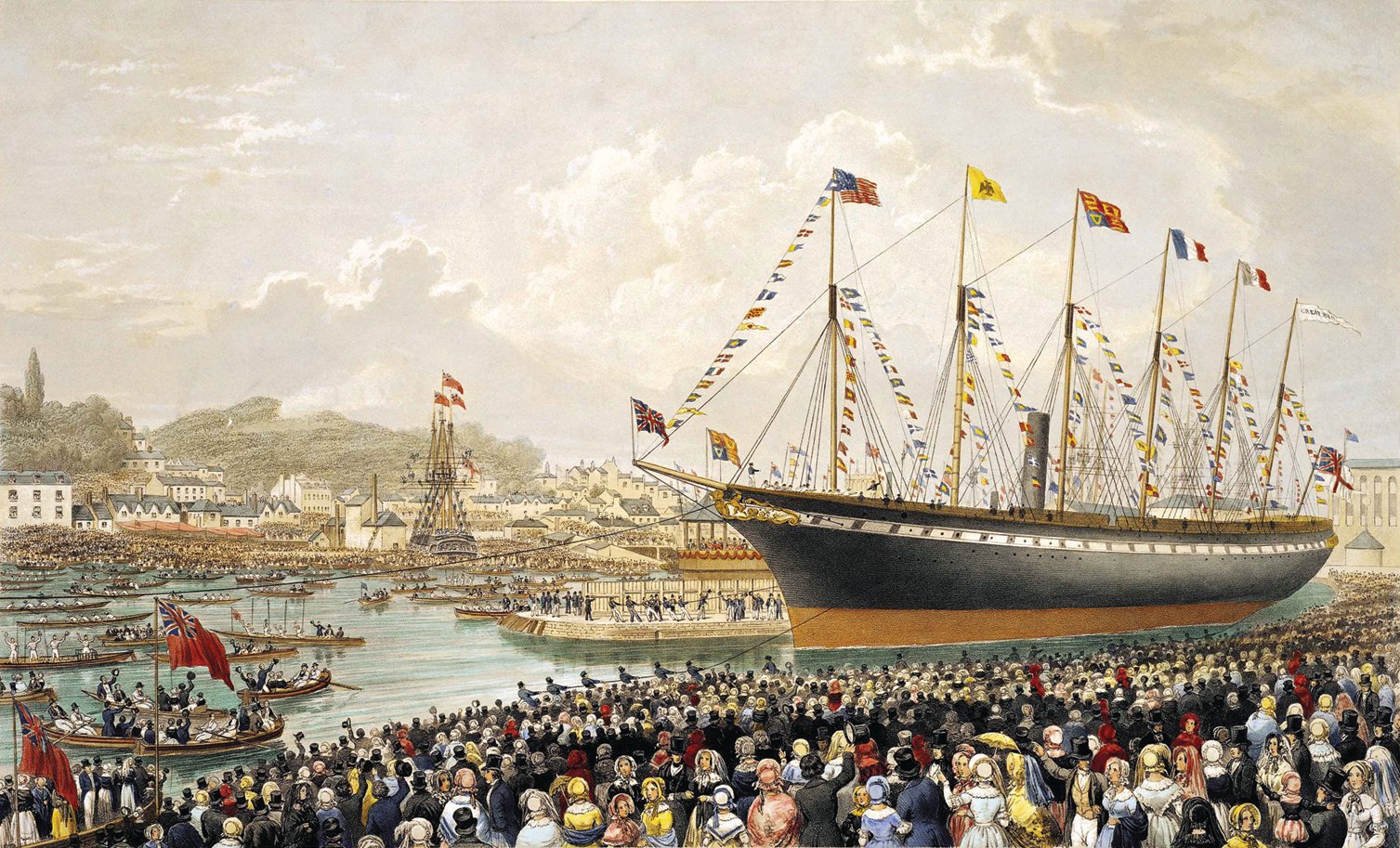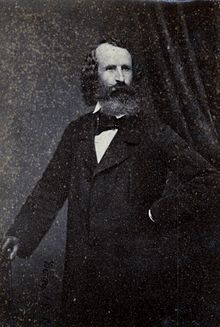Drawn from “Victorian Era” in Wikipedia, The Free Encyclopedia:
Events
- 1832
- Passage of the first Reform Act.[10]

The 1843 launch of theGreat Britain, the revolutionary ship of Isambard Kingdom Brunel
- 1837
- Ascension of Queen Victoria to the throne.[10]
- 1840
- Queen Victoria marries Prince Albert of Saxe-Coburg-Saalfield. He had beennaturalised and granted the British style of Royal Highness beforehand. For the next 17 years, he was known as HRH Prince Albert.
- 1840
- Birth of the Queen’s first child The Princess Victoria. Within months she was granted the title Princess Royal.
- 1840
- New Zealand becomes a British colony, through the Treaty of Waitangi.
- 1841
- Birth of the Queen’s heir-apparent The Prince Albert Edward, Duke of Cornwall (Duke of Rothesay). He was swiftly made Prince of Wales. Sir James Brooke founds the White Rajah dynasty of Sarawak.[11]
- 1842
- Treaty of Nanking. The Massacre of Elphinstone’s Army by the Afghans inAfghanistan results in the death or incarceration of 16,500 soldiers and civilians.[12] The Mines Act of 1842 banned women/children from working in coal,iron, lead and tin mining.[10] The Illustrated London News was first published.[13]
- 1843
- Birth of The Princess Alice
- 1844
- Birth of The Prince Alfred
- 1845
- The Irish famine begins. Within 5 years it would become the UK’s worst human disaster, with starvation and emigration reducing the population of Ireland itself by over 50%. The famine permanently changed Ireland’s and Scotland’s demographics and became a rallying point for nationalist sentiment that pervaded British politics for much of the following century.
- 1846
- Repeal of the Corn Laws.[10]

The last of the mail coaches at Newcastle upon Tyne, 1848
- 1846
- Birth of The Princess Helena
- 1848
- Death of around 2,000 people a week in a cholera epidemic.
- 1848
- Birth of The Princess Louise
- 1850
- Restoration of the Roman Catholic hierarchy in Britain.
- 1850
- Birth of The Prince Arthur
- 1851
- The Great Exhibition (the first World’s Fair) is held at the Crystal Palace,[10] with great success and international attention. The Victorian gold rush. In ten years the Australian population nearly tripled.[14]

The Great Exhibition in London. The United Kingdom was the first country in the world to industrialise.
- 1853
- Birth of The Prince Leopold
- 1854
- Crimean War: The United Kingdom declares war on Russia.
- 1857
- The Indian Mutiny, a widespread revolt in India against the rule of the British East India Company, is sparked by sepoys (native Indian soldiers) in the Company’s army. The rebellion, involving not just sepoys but many sectors of the Indian population as well, is largely quashed within a year. In response to the mutiny, the East India Company is abolished in August 1858 and India comes under the direct rule of the British crown, beginning the period of the British Raj. Prince Albert is given the title The Prince Consort
- 1857
- Birth of The Princess Beatrice
- 1858
- The Prime Minister, Lord Palmerston, responds to the Orsini plot against French emperor Napoleon III, the bombs for which were purchased in Birmingham, by attempting to make such acts a felony; the resulting uproar forces him to resign.
- 1859
- Charles Darwin publishes On the Origin of Species, which leads to various reactions.[10] Victoria and Albert’s first grandchild, Prince Wilhelm of Prussia, is born — he later became William II, German Emperor. John Stuart Mill publishes On Liberty, a defense of the famous harm principle.

Governor-General of IndiaLord Canning meets MaharajaRanbir Singh of Jammu and Kashmir, 1860
- 1861
- Death of Prince Albert;[10] Queen Victoria refuses to go out in public for many years, and when she did she wore a widow’s bonnet instead of the crown.
- 1863
- The Prince of Wales marries Princess Alexandra of Denmark at Windsor.
- 1865
- Alice’s Adventures in Wonderland is published.
- 1866
- An angry crowd in London, protesting against John Russell‘s resignation as Prime Minister, is barred from Hyde Park by the police; they tear down iron railings and trample on flower beds. Disturbances like this convince Derby and Disraeli of the need for further parliamentary reform.
- 1867
- The Constitution Act, 1867 passes and British North America becomes Dominion of Canada.
- 1875
- Britain purchased Egypt‘s shares in the Suez Canal[10] as the African nation was forced to raise money to pay off its debts.
- 1876
- Scottish-born inventor Alexander Graham Bell patents the telephone.
- 1877
- The Princess Alice becomes Grand Duchess of Hesse when her husband succeeds as Louis IV, Grand Duke of Hesse
- 1878
- Treaty of Berlin (1878). Cyprus becomes a Crown colony. The Princess Alice dies. Princess Louise‘s husbandThe Marchioness of Lorne is appointed Governor-General of Canada. First incandescent light bulb by Joseph Wilson Swan.
- 1879
- The Battle of Isandlwana is the first major encounter in the Anglo-Zulu War. Victoria and Albert’s first great-grandchild, Princess Feodora of Saxe-Meiningen, is born.

The defence of Rorke’s Driftduring the Anglo-Zulu War of 1879
- 1882
- British troops begin the occupation of Egypt by taking the Suez Canal, in order to secure the vital trade route and passage to India, and the country becomes a protectorate.
- 1883
- Princess Louise and Lord Lorne return from Canada
- 1884
- The Fabian Society is founded in London by a group of middle class intellectuals, including Quaker Edward R. Pease, Havelock Ellis, and E. Nesbit, to promote socialism.[15] Prince Leopold, Duke of Albany dies.
- 1886
- Prime Minister William Ewart Gladstone and the Liberal Party tries passing the First Irish Home Rule Bill, but theHouse of Commons rejects it.
- 1888
- The serial killer known as Jack the Ripper murders and mutilates five (and possibly more) prostitutes on the streets of London.[10] Victoria’s eldest daughter, the Princess Royal, becomes German Empress when her husband succeeds as Frederick III, German Emperor. Within months, Frederick dies, and their son becomesWilliam II, German Emperor. The widowed Vicky becomes the Dowager Empress as is known as “Empress Frederick”.
- 1870 – 1891
- Under the Elementary Education Act 1870, basic State Education becomes free for every child under the age of 10.[16]
- 1891
- Victoria and Albert’s last grandchild, Prince Maurice of Battenberg, is born.
- 1892
- The Prince of Wales’ eldest son Prince Albert Victor, Duke of Clarence dies of influenza.

Workmen leaving Platt’s Works, Oldham, 1900
- 1893
- The Prince Alfred, Duke of Edinburgh succeeds as Duke of Saxe-Coburg and Gotha when his uncle dies. The Duchy skips over The Prince of Wales due to his renunciation of his succession rights to that Duchy.
- 1898
- British and Egyptian troops led by Horatio Kitchener defeat the Mahdist forces at the battle of Omdurman, thus establishing British dominance in the Sudan. Winston Churchill takes part in the British cavalry charge at Omdurman.
- 1899
- The Second Boer War is fought between the British Empire and the two independent Boer republics.
- 1900
- Alfred, Duke of Saxe-Coburg and Gotha dies. His nephew Prince Charles Edward, Duke of Albany succeeds him, because his brother Prince Arthur, Duke of Connaught and nephew Prince Arthur of Connaught had renounced their rights.
- 1901
- The death of Victoria sees the end of this era. The ascension of her eldest son, Edward, begins the Edwardian era; albeit considerably shorter, this was another time of great change.











